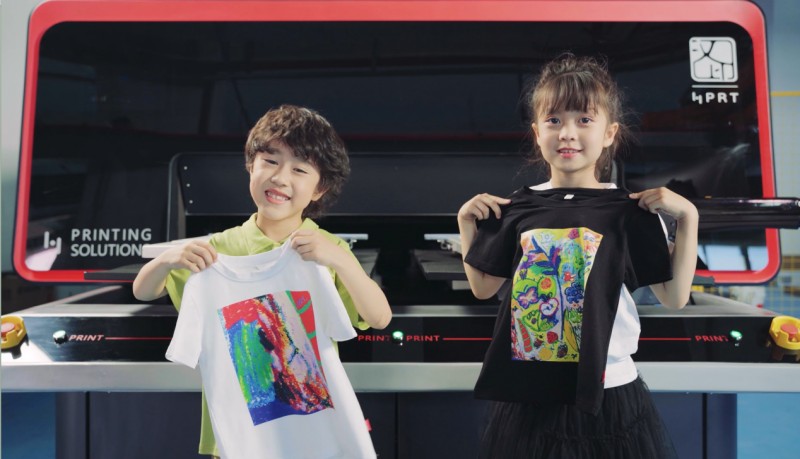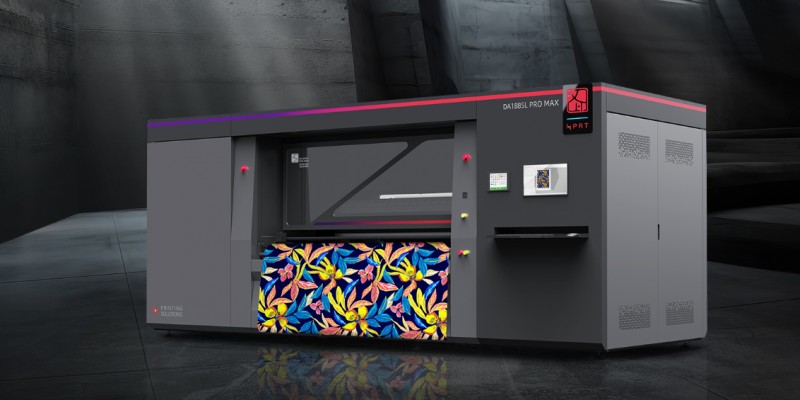Top Six Questions for Choosing Digital Textile Printers: Essential Guide for Clothing Manufacturers and Studios
In today’s industry landscape, more clothing manufacturers, fabric processors, and clothing studios are exploring the world of digital printing. However, when it comes to selecting a digital textile printing machine, there are numerous factors to consider. Beyond the basics like the type of digital printer and the printing process, some crucial aspects often go overlooked.
As a professional digital textile printer manufacturer, HPRT has compiled a list of six key questions to help you make more informed decisions.
What is the Footprint of the Digital Textile Printer?
Space efficiency is vital for smaller clothing manufacturers and studios, limited factory and indoor space is often a concern. Therefore, it’s crucial to consider the equipment’s footprint and overall dimensions, as this directly impacts space utilization efficiency and the layout of production processes.
Larger machines require more workspace, potentially limiting the placement of other equipment in the factory, and this can also affect production costs and operational flexibility.

For instance, in the DTG digital printing, HPRT’s DA067D direct-to-garment printer stands out with its innovative dual-station design and compact design. All these allows for the simultaneous printing of both black and white and color patterns at impressive speeds, reaching up to 160 pieces per hour (A4 size).
Its dimensions, 3800x2710x1900mm, make it an ideal choice for bulk orders of customized apparel such as T-shirts, hoodies, shirts, sportswear, and canvas bags.
Which Fabrics and Ink Types Are Compatible with Digital Textile Printers?
Digital textile printing machines can be divided into direct-to-garment (DTG) printers, direct-to-fabric printers and dye-sublimation printers.
Textile dye sublimation printers typically use dye-sublimation inks suitable for polyester and blended fabrics, while DTG and direct-to-fabric digital fabric printers offer greater versatility, supporting a broader range of fabrics with different digital textile printing ink types.
Cotton | Rayon | Linen | Silk | Wool | Nylon | Polyester | Viscose | |
Disperse Ink | ○ | ○ | ||||||
Reactive Ink | ○ | ○ | ○ | ○ | ○ | |||
Acid Ink | ○ | ○ | ○ |
Apart from the three ink types mentioned above, there’s also the "universal ink"-pigment. Pigment can be used on almost all fabric types and is known for producing vibrant colors and exhibiting excellent wash and lightfastness properties. Its eco-friendly nature in both production and printing processes makes it a forward-thinking choice in the industry.
Currently, HPRT’s DA188S Direct to Fabric Digital Textile Printer, a highly sought-after model, exemplifies this versatility. It uses a range of HPRT’s premium-quality inks, including reactive, acid, dispersed, and pigment inks.
This digital textile printing machine is capable of delivering exceptional results on various fabrics, including cotton, linen, silk, wool, polyester, and blends. Its adaptability and cost-effectiveness have made it a popular choice across fashion, home textiles, and advertising sectors, meeting a wide array of printing requirements.
The DA188S belt drive direct-to-fabric textile printer utilizes a combination of 4-72pl ink droplets to achieve 16-level grayscale, producing high-definition and intricate patterns. It is suitable for applications with high requirements for pattern accuracy and production capacity, such as high-end fashion customization and personalized printing.
What is the Maximum Printing Width of the Digital Textile Printer?
For fabric printing and dyeing factories, the printing width is a crucial consideration when purchasing a digital textile printer.
Standard printers typically offer widths between 1.6 to 1.8 meters, catering to the majority of fabric widths used in everyday clothing, home textiles, and other products.
For instance, HPRT’s DA188S boasts a maximum input width of 1900mm and an actual printing width of 1850mm, perfect for printing items like sportswear, yoga wear, and home textiles including pillows, towels, and indoor decorations.
For larger projects involving oversized curtains, banners, or wide-width fabrics, wide-format digital textile printing machines are the go-to choice. These fabric printers can handle widths up to 3.2 meters or more.
HPRT is expanding its range to include such wide-format printers, aiming to cater to a broader spectrum of printing needs, including large-scale soft signage and banners.
What Color Options Are Available in Digital Textile Printing?
Common ink colors for digital printing machines are C, M, Y, and K. Manufacturers may add additional colors based on product positioning and functionality. The more ink colors available, the more subtle shades and gradients the fabric printer can create.
For example, HPRT’s DA188S direct-to-fabric digital textile printer uses a total of 12 ink colors, including C, M, Y, K, O, B, R, Lk, Lm, Lc, FM and FY, offering a color range of tens of millions.

In addition to ink colors, the arrangement of the print heads is a crucial factor in determining the color printing range. HPRT’s latest fabric printing machine DA188SL PRO features a single row of 16 print heads arranged symmetrically in 8 colors. Compared to traditional 8x2 dual-row 8-color print head arrangements, it offers higher printing accuracy, eliminates any color discrepancies, provides greater coverage of patterns, and is more cost-effective.

What Software Is Used in Digital Textile Printing and How Compatible Is It?
Digital textile printing machine manufacturers often develop proprietary software to meet the unique requirements of their products. HPRT has a professional software development team that has created user-friendly, powerful RIP system tailored to the product’s characteristics-HPRT PRINT.
To cater to diverse user needs, we have extensively tested and optimized HPRT PRINT to be compatible with popular digital printing software on the market, such as NeoStampa. This means that when users switch to HPRT digital fabric printers, they can seamlessly integrate them without the need for relearning the software, greatly enhancing work efficiency and user experience.
Does the Digital Textile Printer Supplier Provide Pre- and Post-Treatment Equipment?
When considering a digital textile printing machine, it’s wise to think about complete printing and processing solutions. Purchasing from a single supplier, like HPRT, ensures technical compatibility and smooth operation.
HPRT is committed to offering customers a one-stop solution for digital fabric printing, complemented by professional drying ovens and pre- and post-treatment equipment.
HPRT’s DA188SL series, for example, integrates inline pre-treatment module, streamlining the process, eliminating the need for a separate sizing step and the associated equipment. Additionally, this fabric printer employs a wet printing technique, ensuring deep ink penetration and high saturation while using less ink, thereby enhancing cost-effectiveness.
If your factory or studio is considering purchasing cost-effective digital textile printers or thinking about upgrading digital textile printing machines by introducing emerging features such as online pretreatment, please feel free to contact us. HPRT will provide you with a customized digital printing solution tailored to your needs.








